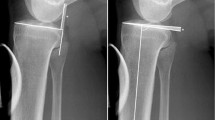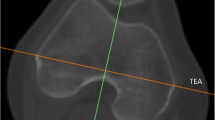Abstract
Purpose
The purpose of this study was to describe the medial and lateral posterior tibial slope (MPTS and LPTS) on 3D-CT in a Caucasian population without osteoarthritis. It was hypothesised that standard TKA alignment techniques would not reproduce the anatomy in a high percentage of native knees.
Methods
CT scans of 301 knees [male:female = 192:109; mean age 30.1 (\(\pm\) 6.1)] were analysed retrospectively. Tibial slope was measured medially and laterally in relation to the mechanical axis of the tibia. The proportion of MPTS and LPTS was calculated, corresponding to the “standard PTS” of 3°–7°. The proportion of knees accurately reproduced with the recommended PTS of 0°–3° for PS and 5°–7° for CR TKA were evaluated.
Results
Interindividual mean values of MPTS and LPTS did not differ significantly (mean (range); MPTS: 7.2° ( – 1.0°–19.0°) vs. LPTS: 7.2° ( − 2.4°–17.8°), n.s.). The mean absolute intraindividual difference was 2.9° (0.0°–10.8°). In 40.5% the intraindividual difference between MPTS and LPTS was > 3°. When the standard slope of 3°–7° medial and lateral was considered, only 15% of the knees were covered. The tibial cut for a PS TKA or a CR TKA changes the combined PTS (MPTS + LPTS) in 99.3% and 95.3% of cases, respectively.
Conclusion
A high interindividual range of MPTS and LPTS as well as considerable intraindividual differences were shown. When implementing the recommended slope values for PS and CR prostheses, changes in native slope must be accepted. Further research is needed to evaluate the impact of altering a patient’s native slope on the clinical outcome.
Level of evidence
IV.





Similar content being viewed by others
Abbreviations
- ACL:
-
Anterior cruciate ligament
- AP:
-
Anterior – posterior
- CR:
-
Cruciate retaining
- MPTS:
-
Medial posterior tibial slope
- OA:
-
Osteoarthritis
- ROM:
-
Range of motion
- PCL:
-
Posterior cruciate ligament
- PS:
-
Posterior stabilized
- PTS:
-
Posterior tibial slope
- ROM:
-
Range of motion
- LPTS:
-
Lateral posterior tibial slope
- TKA:
-
Total knee arthroplasty
- 3D:
-
Three dimensional
References
Bai B, Baez J, Testa NN, Kummer FJ (2000) Effect of posterior cut angle on tibial component loading. J Arthroplasty 15:916–920
Bellemans J, Robijns F, Duerinckx J, Banks S, Vandenneucker H (2005) The influence of tibial slope on maximal flexion after total knee arthroplasty. Knee Surg Sports Traumatol Arthrosc 13:193–196
Catani F, Leardini A, Ensini A, Cucca G, Bragonzoni L, Toksvig-Larsen S, Giannini S (2004) The stability of the cemented tibial component of total knee arthroplasty posterior cruciate-retaining versus posterior-stabilized design1 1No benefits or funds were received in support of this study. J Arthroplasty 19:775–782
Chambers AW, Wood AR, Kosmopoulos V, Sanchez HB, Wagner RA (2016) Effect of posterior tibial slope on flexion and anterior-posterior tibial translation in posterior cruciate-retaining total knee arthroplasty. J Arthroplasty 31:103–106
Figueroa J, Guarachi JP, Matas J, Arnander M, Orrego M (2016) Is computed tomography an accurate and reliable method for measuring total knee arthroplasty component rotation? Int Orthop 40:709–714
Fucentese SF, Meier P, Jud L, Köchli G-L, Aichmair A, Vlachopoulos L, Fürnstahl P (2020) Accuracy of 3D-planned patient specific instrumentation in high tibial open wedge valgisation osteotomy. J Exp Orthop 7:7. https://doi.org/10.1186/s40634-020-00224-y
Henckel J, Richards R, Lozhkin K, Harris S, y Baena FMR, Barrett ARW, Cobb JP (2006) Very low-dose computed tomography for planning and outcome measurement in knee replacement. J Bone Joint Surg Br 88-B:1513–1518
Hirschmann MT, Moser LB, Amsler F, Behrend H, Leclercq V, Hess S (2019) Phenotyping the knee in young non-osteoarthritic knees shows a wide distribution of femoral and tibial coronal alignment. Knee Surg Sports Traumatol Arthrosc 27:1385–1393
Hirschmann MT, Moser LB, Amsler F, Behrend H, Leclerq V, Hess S (2019) Functional knee phenotypes: a novel classification for phenotyping the coronal lower limb alignment based on the native alignment in young non-osteoarthritic patients. Knee Surg Sports Traumatol Arthrosc 27:1394–1402
Hoch A, Jud L, Roth T, Vlachopoulos L, Fürnstahl P, Fucentese SF (2020) A real 3D measurement technique for the tibial slope: differentiation between different articular surfaces and comparison to radiographic slope measurement. BMC Musculoskelet Disord 21:635. https://doi.org/10.1186/s12891-020-03657-9
Hochreiter B, Hirschmann MT, Amsler F, Behrend H (2019) Highly variable tibial tubercle–trochlear groove distance (TT–TG) in osteoarthritic knees should be considered when performing TKA. Knee Surg Sports Traumatol Arthrosc 27:1403–1409
Jud L, Vlachopoulos L, Beeler S, Tondelli T, Fürnstahl P, Fucentese SF (2020) Accuracy of three dimensional-planned patient-specific instrumentation in femoral and tibial rotational osteotomy for patellofemoral instability. Int Orthop. https://doi.org/10.1007/s00264-020-04496-y
Kang K-T, Koh Y-G, Son J, Kwon O-R, Lee J-S, Kwon SK (2017) Biomechanical effects of posterior condylar offset and posterior tibial slope on quadriceps force and joint contact forces in posterior-stabilized total knee arthroplasty. Biomed Res Int 2017:1–12
Kang K-T, Kwon SK, Son J, Kwon O-R, Lee J-S, Koh Y-G (2018) The increase in posterior tibial slope provides a positive biomechanical effect in posterior-stabilized total knee arthroplasty. Knee Surg Sports Traumatol Arthrosc 26:3188–3195
Kuwano T, Urabe K, Miura H, Nagamine R, Matsuda S, Satomura M, Sasaki T, Sakai S, Honda H, Iwamoto Y (2005) Importance of the lateral anatomic tibial slope as a guide to the tibial cut in total knee arthroplasty in Japanese patients. J Orthop Sci 10:42–47
Lustig S, Scholes CJ, Leo SPM, Coolican M, Parker DA (2013) Influence of soft tissues on the proximal bony tibial slope measured with two-dimensional MRI. Knee Surg Sports Traumatol Arthrosc 21:372–379
Malviya A, Lingard EA, Weir DJ, Deehan DJ (2009) Predicting range of movement after knee replacement: the importance of posterior condylar offset and tibial slope. Knee Surg Sports Traumatol Arthrosc 17:491–498
Meier M, Janssen D, Koeck FX, Thienpont E, Beckmann J, Best R (2020) Variations in medial and lateral slope and medial proximal tibial angle. Knee Surg Sports Traumatol Arthrosc. https://doi.org/10.1007/s00167-020-06052-y
Meier M, Zingde S, Best R, Schroeder L, Beckmann J, Steinert AF (2020) High variability of proximal tibial asymmetry and slope: a CT data analysis of 15,807 osteoarthritic knees before TKA. Knee Surg Sports Traumatol Arthrosc 28:1105–1112
Meric G, Gracitelli GC, Aram L, Swank M, Bugbee WD (2015) Tibial slope is highly variable in patients undergoing primary total knee arthroplasty: analysis of 13,546 computed tomography scans. J Arthroplasty 30:1228–1232
Mizu-uchi H, Colwell CW, Matsuda S, Flores-Hernandez C, Iwamoto Y, D’Lima DD (2011) Effect of total knee arthroplasty implant position on flexion angle before implant-bone impingement. J Arthroplasty 26:721–727
Naendrup J-H, Drouven SF, Shaikh HS, Jaecker V, Offerhaus C, Shafizadeh ST, Pfeiffer TR (2020) High variability of tibial slope measurement methods in daily clinical practice: comparisons between measurements on lateral radiograph, magnetic resonance imaging, and computed tomography. Knee. https://doi.org/10.1016/j.knee.2020.01.013
Nunley RM, Nam D, Johnson SR, Barnes CL (2014) Extreme variability in posterior slope of the proximal tibia: measurements on 2395 CT scans of patients undergoing UKA? J Arthroplasty 29:1677–1680
Pangaud C, Laumonerie P, Dagneaux L, LiArno S, Wellings P, Faizan A, Sharma A, Ollivier M (2020) Measurement of the posterior tibial slope depends on ethnicity, sex, and lower limb alignment: a computed tomography analysis of 378 healthy participants. Orthop J Sports Med. https://doi.org/10.1177/2325967119895258
Shi X, Shen B, Kang P, Yang J, Zhou Z, Pei F (2013) The effect of posterior tibial slope on knee flexion in posterior-stabilized total knee arthroplasty. Knee Surg Sports Traumatol Arthrosc 21:2696–2703
Sierra RJ, Berry DJ (2008) Surgical technique differences between posterior-substituting and cruciate-retaining total knee arthroplasty. J Arthroplasty 23:20–23
Singh G, Tan JH, Sng BY, Awiszus F, Lohmann CH, Nathan SS (2013) Restoring the anatomical tibial slope and limb axis may maximise post-operative flexion in posterior-stabilised total knee replacements. Bone Joint J 95-B:1354–1358
Utzschneider S, Goettinger M, Weber P, Horng A, Glaser C, Jansson V, Müller PE (2011) Development and validation of a new method for the radiologic measurement of the tibial slope. Knee Surg Sports Traumatol Arthrosc 19:1643–1648
Wasieliwski RC, Galante JO, Leighty RM, Natarajan RN, Rosenberg AG (1994) Wear patterns on retrieved polyethylene tibial inserts and their relationship to technical considerations during total knee arthroplasty. Clin Orthop Relat Res 299:31–43
Wittenberg S, Sentuerk U, Renner L, Weynandt C, Perka CF, Gwinner C (2019) Importance of the tibial slope in knee arthroplasty. Der Orthopade 49:10–17
Funding
No direct support for this project was received.
Author information
Authors and Affiliations
Contributions
AKC and BH were involved in the conceptualization and design of the study. AKC, BH, and FA were involved in analysis and interpretation of the data. AKC and BH were drafting the manuscript. SH, HB, and MTH were involved in manuscript revision. All authors edited, read, and approved the final manuscript.
Corresponding author
Ethics declarations
Conflict of interest
MTH and FA are paid by DepuySynthes, Lima, S&N, Symbios. MTH is a board member of ESSKA, EKA and DKG, and a member of the editorial team of KSSTA, AP SMART, World J Orthopaedics. All the other authors declare that they have no competing interests.
Ethics approval and consent to participate
Approval was obtained from the local ethical committee (Ethikkommission Nordwest- und Zentralschweiz, ID 2018-00223). All procedures performed were in accordance with the ethical standards of the institutional and/or the national research committees and with the 1964 Declaration of Helsinki and its later amendments or with comparable ethical standards.
Informed consent
Informed consent was obtained from all participants of the study.
Consent for publication
Not applicable.
Additional information
Publisher's Note
Springer Nature remains neutral with regard to jurisdictional claims in published maps and institutional affiliations.
Rights and permissions
About this article
Cite this article
Calek, AK., Hochreiter, B., Hess, S. et al. High inter- and intraindividual differences in medial and lateral posterior tibial slope are not reproduced accurately by conventional TKA alignment techniques. Knee Surg Sports Traumatol Arthrosc 30, 882–889 (2022). https://doi.org/10.1007/s00167-021-06477-z
Received:
Accepted:
Published:
Issue Date:
DOI: https://doi.org/10.1007/s00167-021-06477-z




